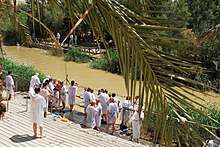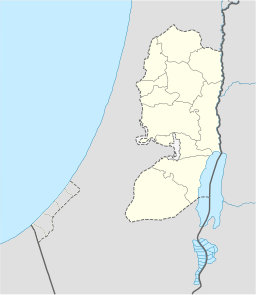Qasr al-Yahud
Qasr al-Yahud (Arabic: قصر اليهود; also Kasser/Qasser al-Yahud/Yehud etc.; lit. "The tower of the Jews",[1] Hebrew: קאסר אל יהוד) is the official name of a baptism site in the Jordan River Valley in the West Bank. After the Six-Day War in 1967, it has been placed under Israeli control, and the site and facilities are administered by the Israeli Civil Administration and the Israeli Ministry of Tourism as part of a national park.
قصر اليهود | |
 | |
 Shown within the West Bank | |
| Alternative name | Al-Maghtas |
|---|---|
| Location | Jericho Governorate, West Bank (claimed by the State of Palestine) |
| Coordinates | 31.838333°N 35.539167°E |
| Palestine grid | 201/138 |
It is the western part of the traditional site of the baptism of Jesus by John the Baptist (Matthew 3:13-17), in Arabic Al-Maghtas, a name which was historically used for the pilgrimage site on both sides of the river. It is also traditionally considered to be the place where the Israelites crossed the Jordan River,[2] and the prophet Elijah ascended to heaven.[3]
Etymology
The Arabic name of the baptism site is Al-Maghtas meaning "immersion" and, by extension, "baptism", used for an area stretching over both banks of the river. The Jordanian side uses the names Al-Maghtas, Bethany beyond the Jordan and Baptism(al) Site, while the western part is known as Qasr al-Yahud. The nearby Greek Orthodox Monastery of St John the Baptist has a castle-like appearance (thus qasr, "castle"), and tradition holds that the Israelites crossed the river at this spot (thus al-Yahud, "of the Jews").[4][5][6]
Location
Qasr al-Yahud is located in the West Bank, a little southeast from Jericho and is part of the Jericho Governorate of Palestine.[7]
History
Antiquity
Qasr al-Yahud is close to the ancient road and river ford connecting Jerusalem, via Jericho, to several Transjordanian biblical sites such as Madaba, Mount Nebo and the King's Highway.[7]
According to Procopius (writing c. 560 CE), Emperor Justinian I had a cistern constructed here.[8] In 1883 it was described as "still visible, in almost perfect condition".[9]
19th and 20th century
_(cropped).jpg)
The west side of the traditional baptism site became again a target for mass pilgrimage toward the end of the 19th and beginning of the 20th century. Later in the century, a large number of churches and monasteries were built between the old Greek Orthodox Monastery of St John the Baptist and the river, an area that became known as the "Land of the Monasteries". It comprised Catholic (Franciscan), Greek, Ethiopian Orthodox, Syriac, Russian, Romanian, and Coptic churches.[10][11]
After 1967
The modern site reopened in 2011 after being closed since the 1967 Six-Day War.[7] The restoration project was approved before the 2000 millennium celebrations but was delayed due to the Second Intifada and flooding in the region in 2003.[2] In 2000, Pope John Paul II held a private worship at the site.[2]
Qasr al-Yahud is administered by the Israeli Civil Administration and the Israeli Ministry of Tourism. Before the site became accessible, baptisms took place at Yardenit.
 broader view
broader view Renovated facilities at Qasr al-Yahud
Renovated facilities at Qasr al-Yahud Baptism site
Baptism site Both baptism ends across Jordan river
Both baptism ends across Jordan river Facility at Baptism center Jericho end
Facility at Baptism center Jericho end
References
- Palmer, 1881, p. 346
- Ginat, Gitit (14 January 2010). "Take me to the river". Haaretz. Retrieved 1 August 2017.
- "Jesus's baptismal site, long sealed off, to be cleared of landmines". The Times of Israel. 16 May 2016. Retrieved 1 August 2017.
- "Survey of Western Palestine, sheet 15". Palestine Exploration Fund. Retrieved 23 March 2015.
- Theodosios Mitropoulos, architect. "The Holy Monastery of St John the Baptist on the banks of the Jordan River/Qasr-el-Yahud". The [Greek Orthodox] Patriarchate of Jerusalem – Official News Gate. Archived from the original on 2 April 2015. Retrieved 23 March 2015.
The Holy Monastery of St John the Baptist on the banks of the Jordan River/Qasr-el-Yahud […] The perimeter walls, specifically their uppermost portion, terminate at battlements, which lend the monument the form of a Medieval castle. This is in all likelihood why its Arab name is Qasr al-Yahud [The castle of the Jews]
- Othmar Keel; Max Küchler; Christoph Uehlinger (1992). Orte und Landschaften der Bibel, Volume 2. Vandenhoeck & Ruprecht. p. 528. ISBN 9783525501672. Retrieved 23 March 2015.
- "In rivalry over Jesus' baptism site, UNESCO backs Jordan over West Bank, as debate goes on". Fox News World. Al-Maghtas, Jordan. Retrieved August 1, 2017.
- Procopius, 1888, p. 149: "in the monastery of St. John beside the Jordan, a cistern"
- Conder and Kitchener, 1883, SWPIII, p. 177
- Anshel, Pfeffer (11 April 2020). "Jesus's baptism site is cleared of Israeli mines". The Times. Retrieved 18 April 2020.
- Lidman, Melanie (8 January 2019). "Effort removes thousands of landmines from site of Jesus' baptism". Retrieved 18 April 2020.
Bibliography
- Conder, C.R.; Kitchener, H.H. (1883). The Survey of Western Palestine: Memoirs of the Topography, Orography, Hydrography, and Archaeology. 3. London: Committee of the Palestine Exploration Fund. (inscriptions and several graphitæ at, 181, 218; general description, 217)
- Guérin, Victor (1874). Description Géographique Historique et Archéologique de la Palestine (in French). 2: Samarie, pt. 1. Paris: L'Imprimerie Nationale. (in 1870: pp. 111-116)
- Palmer, E.H. (1881). The Survey of Western Palestine: Arabic and English Name Lists Collected During the Survey by Lieutenants Conder and Kitchener, R. E. Transliterated and Explained by E.H. Palmer. Committee of the Palestine Exploration Fund.
- Procopius (1888). Of the buildings of Justinian. Palestine Pilgrims' Text Society.
- Robinson, E.; Smith, E. (1841). Biblical Researches in Palestine, Mount Sinai and Arabia Petraea: A Journal of Travels in the year 1838. 2. Boston: Crocker & Brewster. (p. 257, 270)
- Robinson, E.; Smith, E. (1841). Biblical Researches in Palestine, Mount Sinai and Arabia Petraea: A Journal of Travels in the year 1838. 3. Boston: Crocker & Brewster. (2 appendix, p. 122)
External links
- Survey of Western Palestine, Map 18: IAA, Wikimedia commons
- Qasr al-Yahud, Israel's Nature and Parks Authority